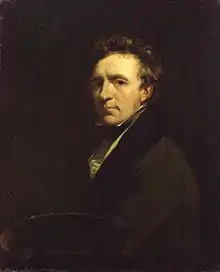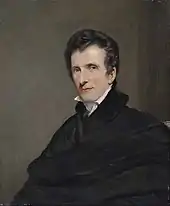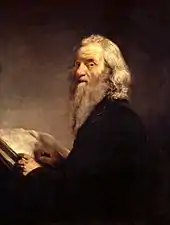John Jackson | |
|---|---|
 Self-portrait, c. 1823 | |
| Born | 31 May 1778 |
| Died | 1 June 1831 (aged 53) |
| Nationality | British |
| Occupation | Painter |
| Spouses | Maria Frances Fletcher
(m. 1808; died 1817)Matilda Louisa Ward (m. 1818) |


John Jackson RA (31 May 1778 – 1 June 1831) was a British portraitist.
John Jackson was baptised on 31 May 1778 [1] in Lastingham, Yorkshire, and started his career as an apprentice tailor to his father, also John Jackson, who opposed the artistic ambitions of his son. John Jackson’s mother was Ann Warrener and he had at least one brother, Roger Jackson.
However, John enjoyed the support of Henry Phipps, 1st Earl of Mulgrave (1755–1831), who recommended him to the Earl of Carlisle; as well as that of Sir George Beaumont, 7th Baronet, who offered him residence at his own home and £50 per year. As a result, Jackson was able to attend the Royal Academy Schools, where he befriended David Wilkie and B. R. Haydon. At Castle Howard, residence of the Earl of Carlisle, he could study and copy from a large collection of paintings. His watercolours were judged to be of uncommon quality.[2]
By 1807 Jackson's reputation as a portrait painter had become established, and he made the transition to oils steadily, if not easily, regularly forwarding paintings to Somerset House. After a visit to the Netherlands and Flanders with Edmund Phipps in 1816, he accompanied Sir Francis Chantrey on a trip to Switzerland, Rome, Florence and Venice in 1819. In Rome he was elected to the Academy of St Luke. His portrait of Antonio Canova, painted on this trip, was regarded as outstanding.[2]
Jackson was a prolific portraitist, strongly showing the influence of Sir Thomas Lawrence and Henry Raeburn in his work.[3] His sitters included the Duke of Wellington, the explorer Sir John Franklin and some noted Wesleyan ministers.[4] His 1823 portrait of Lady Dover, wife of George Agar-Ellis, 1st Baron Dover, was widely acclaimed.[5]
He was a Royal Academy student from 9 March 1805, was elected an Associate of the RA on 6 November 1815 and elected a full member on 10 February 1817.[6]
John Jackson was married twice, the first marriage in 1808 was to Maria Frances Fletcher, the daughter of a jeweller, Samuel Fletcher. His second marriage in August 1818 was to Matilda Louisa Ward, the daughter of the painter James Ward and a niece of George Morland. He died in 1831 in St John's Wood, London.[2][5]
He had three children with his first wife Maria: Maria Rosa Jackson was born in 1808 and died in 1888. His son Charles Fletcher Jackson was born in 1810 and died in infancy in 1811. His second son, John Edmund Jackson was born in 1816 and again died in infancy in March 1817. John Jackson’s first wife Maria also died in March 1817 shortly before their son John Edmund died.
John's first daughter, Maria Rosa Jackson married Marmaduke Brewer and she later ran a school in Monmouthshire.
Jackson had three confirmed children with Matilda. His first son, Howard William Mansfield Jackson was born in 1824. His second son with Matilda, Mulgrave Phipps Jackson, who went on to exhibit his own work at the Royal Academy, was born in 1830.[7] John Jackson also had a daughter with Matilda, Matilda Louisa, born 1825.
Further reading
- Michael Bryan; George Stanley (1849). A Biographical and Critical Dictionary of Painters and Engravers: From the Revival of the Art under Cimabue, and the Alleged Discovery of Engraving by Finiguerra, to the Present Time: With the Ciphers, Monograms, and Marks, Used by each Engraver: by Michael Bryan. A New Edition, Revised, Enlarged, and Continued to the Present Time, Comprising above One Thousand Additional Memoirs, and Large Accessions to the Lists of Pictures and Engravings; also New Plates of Ciphers and Monograms, by George Stanley (new, rev. & enl. ed.). London: H. G. Bohn. p. 355. OCLC 154060793.
References
- ↑ "FamilySearch.org". Retrieved 6 July 2023.
- 1 2 3 Thomas Smith (1833). A Topographical and Historical Account of the Parish of St. Mary-le-Bone, Comprising a Copious Description of its Public Buildings, Antiquities, Schools, Charitable Endowments, Sources of Public Amusement, &c. with Biographical Notices of Eminent Persons. Illustrated with Six Views and a Map. London: J. Smith. pp. 296–297. OCLC 1986604.
- ↑ John Jackson (1998). Grove Art. Oxford: Oxford University Press (reproduced on Answers.com). ISBN 978-1-884446-05-4. Retrieved 24 October 2014.
- ↑ Dee Helmore. "William Gush – Portrait Painter". Institute of Heraldic and Genealogical Studies. Archived from the original on 22 August 2014. Retrieved 23 October 2014.
- 1 2 [Clarke] (1834). The Georgian Era: Memoirs of the Most Eminent Persons, who have Flourished in Great Britain, from the Accession of George the First to the Demise of George the Fourth: In Four Volumes. Volume IV. Political and Rural Economists; Painters, Sculptors, Architects, and Engravers; Composers; Vocal, Instrumental, and Dramatic Performers. London: Vizetelly, Branston and Co. pp. 135–136. OCLC 2043748.
- ↑ "John Jackson, R. A." Royal Academy of Arts. Archived from the original on 23 October 2014. Retrieved 24 October 2014.
- ↑ "ChapterB".
External links
- 102 artworks by or after John Jackson at the Art UK site.